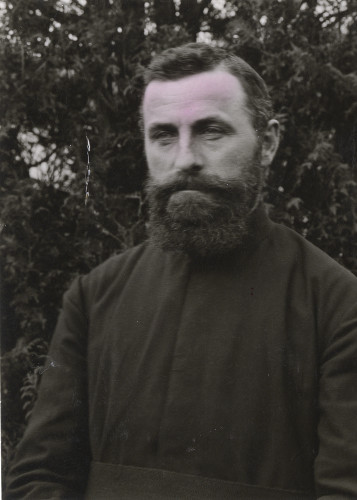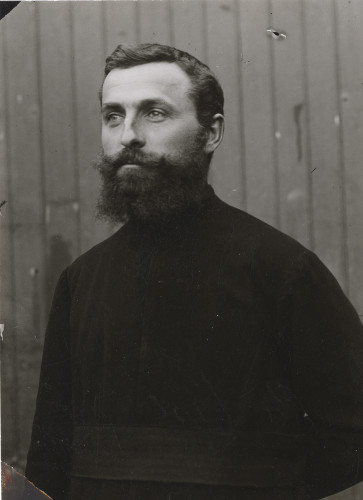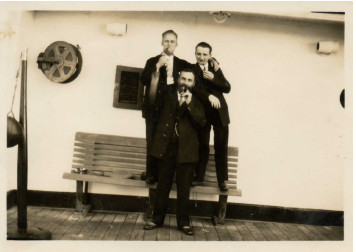Nissl, Franz Br. (1888-1980)
born 6 April 1988 Attenkirchen, Freising (Bavaria)
died 19 February 1980, Melbourne, age 92
Pallottine Br. Frank, a farmer at Tardun appears to have deeply influenced the people around him and was the subject of a published biography.
Childhood
Franz was the second of six children of carpenter Franz and Ursula in Attenkirchen (Bavaria). His siblings were Johann, Martin (Mertin in Byrne 1989), Kresenz, Ursula and Maria. In 1890 the family moved to Langenbach (12 km away) a village without parish priest and only a small chapel. The children attended the Volksschule in the morning and helped at home in the afternoon, tending three cows and some pigs and a small plot of land. If they misbehaved, there was the strap. Franz (Sr.) became foreman in the construction of a bridge over the Amper River and sometimes the older children had to bring him home from the Wirtshaus (pub). The family performed their prayers in the morning, for the midday meal and at bedtime, and recited the Rosary on Saturdays. If they went to Freising they would visit the cathedral where each child would be lifted up to kiss the Statue of Mother Mary. Frank was eight when his mother died at age 36.1
Two years later his father re-married and resorted to a common strategy of dealing with poverty: Franz was adopted out to a family in Tonstetten, three kilometers away. That family’s daughter Magdalena was crippled by polio, so for the next four years, until he completed school, he pushed her to school and home again in a home-made pram and carried her to her classroom. This became a formative experience for him. When he was ready to earn money, he was called home again, and soon afterwards his father died at age 43. The two oldest boys worked on a nearby farm and the younger ones continued to tend the vegetables for sale from the family plot. During a period in hospital when a horse had trampelled his toe he chanced across a juvenile book on overseas missionaries that left a deep impression. At age 19 he asked the parish priest to help him become a Pallottine Brother. In February 1908 he left for Limburg without informing his siblings of his plans and for the first time in his life felt free. 2
Training
In Limburg he made his way to the ‘palatial mission house’ and ‘stepped into a world of holiness’. There were 150 Pallottines including 50 Brothers and a 100-acre farm. He worked and prayed in the Limburg rythm for two years with strict silence in the corridors and rooms and minimal interaction at meals – silence is the food of the soul - and made his first profession in September 1910 and swore to be ‘prepared to undergo the difficulties of the Apostolic Life: namely poverty, hunger, thirst, nakedness, reproach, contempt and all those things which are necessary for the propagation of the greater glory of God and the salvation of souls’. None of his family or friends were able to be present at the ceremony.
Shortly afterwards all young men over the age of twenty were called up for military service and Br. Franz with eight others took the train to the Frankfurt barracks in October 1910 for two years of training. After two more years in Limburg he was called up for the Western Front. He opted for the ‘horse brigade’ carting supplies and narrowly missed a bomb explosion. Later he was on the eastern front in Serbia and Croatia during winter. Seventy Pallottines were among the 1.8 million German soldiers who died during World War I. Germany lost its Cameroon colony that was the raison d’être for the Limburg mission house.
Brother Franz was 35 when he returned from four years of war, and made his final profession in November 1919. He spent two more years in Limburg, then two years farming at Schönstatt (Vallendar) and seven years at Rößel (1925-1931) where he became farm manager at Klawsdorf.3 According to Bleischwitz it was Fr. Benedikt Püsken who told Bishop Raible that this Brother was what they needed in the Kimberley.4
To the mission
Before his departure from Europe Nissl was privileged to see Pope Pius XI. Brothers from various religious orders were kneeling ‘in a large assembly room in the Vatican. The Pope entered, slightly tired-looking in the face, gave them his Papal Blessing and wished them success’.5
|
|
|
The three Brothers on their way to Australia. |
In May 1931 Nissl travelled travelled with Brs. Paul Müller and Bernhard Stracke on the Samson from Hamburg to Singapore and on the Centaur to Broome, with a stop-over in Derby, which they found so disappointing that they spent the time on board. ‘All we saw was a few houses and a tree in the middle of the street. Nothing else. Later on we saw a few white people. There was no Catholic Church there either.’6 Their English was not sufficient to order lunch from a menu.
Frs Worms and Raible greeted them in Broome. Raible, now with a substantial beard and in charge of a large vicariate, was unrecognisable from the young student in Limburg in 1910. They were all born within a few years of each other, Nissl being the older. Worms had been Nissl’s rector in Rößel and had only arrived six months earlier. One of the young Aborigines wanted to know news about Fr. Droste. When he heard of Droste’s death, ‘the Aborigines’s face fell’.7
The group stayed in Broome for two weeks before heading for the new farm at Tardun with a stopover in Geraldton, where the Bishop was away and Nissl got to sleep in his bed, the last proper bed for years.
Tardun Farm (1931-38)
The Tardun farm accommodation consisted of a shed divided into sections by hessian with mattresses on the floor and wooden boxes for seats. They had 1000 sheep and started ploughing to sow wheat, with great success. When the harvest came in they faced a slump in prices as the Depression was starting to bite and their attempt to stockpile and wait for better prices was washed out in rains. At other times the sheep were dying from drought.
They battled with heat, rain seeping through the roof, insects and snakes. Brother Frank said that regardless of all the lotions they tried out, the sandflies ‘would sit on every inch of flesh they could find and literally leave holes in it’. Once as he was lying on his mattress a brown snake emerged from underneath. ‘Don’t move’ yelled a Brother and rushed to grab an axe.8
They rose to prayers and mass at 5am, and started to work after breakfast, with lunch on the paddocks. The Geraldton Bishop expressed reservations about holding the Blessed Sacrament in the end section of their primitive shed that they called a chapel. They hired an Italian bricklayer and set about building a brick monastery alongside a few weatherboard houses and a small store at the Tardun railway siding. It had ten rooms, a refectory, a chapel and a verandah, and Bishop Raible came to open it in 1938.
Balgo, Beagle Bay and a visit home
No sooner was Tardun fully established that Br. Frank was called to Beagle Bay and from there in May 1939 to help wind down Rockhole mission. He participated in the long trek from Rockhole to Balgo described by Bleischwitz, and remained there for the first eight years, again building up a workable farm from scratch. Actually the German Brothers were required to remain there for the duration of World War II and not permitted to travel.
In 1947 he returned to Beagle Bay to tend a 2,000 strong mob of cattle, and built holding yards 30km off the mission.
.jpg) |
|
Alfons Bleischwitz, Bishop Raible, Franz Nissl Source: Pallottis Werk 1954/4. |
In 1954 he was allowed a visit to Germany, travelling with Bishop Raible and Fr. Alphonse Bleischwitz from Broome to Fremantle, and from there to Southhampton via South Africa where they visited several Pallottine missions. In London they happened to see the Queen pass by with a royal entourage. The journey took 70 days, and his holiday was for a year – ‘too long’ the 66-year-old felt. Only two of his five siblings had survived, his elder brother Johann and his younger sister Kresenz. Like Brother Wollseifer twenty years earlier, he felt a loss of purpose from being taken away from the missions. He did, however, inspire his namesake nephew, Frank Nissl (Jr.) to join them at Beagle Bay for a year, gaining a sponsorship from Bishop Raible to gain a visa. Frank (Jr.) migrated to Australia.
Late in 1955 he returned to Beagle Bay to work with the stock and around the monastery. Among his responsibilities were the 100-strong pig herd and the fowls, and he once had to remove a 15-foot brown snake from the fowl house. In 1957 he rode out a cyclone in the Beagle Bay church together with the other mission residents, and in 1959 new staff arrived from Germany. One of them described Br. Nissl as:
‘always ready to spill a joke over the table. Sometimes he laughed more than the rest of us after his jokes.’
‘... the Aborigines who rode out with him every day .... liked him a lot, as did all the people in the camp. Whenever I visited them in the bush, it was an uplifting experience. At night they would gather quite naturally to recite the Rosary and the Litany to Our Lady just as they would if they were back at the mission.’ 9
Non-retirement
At age 71 Br. Nissl returned to Tardun, which had become a modern place with farm machinery, a swimming pool and a school full of pupils. He stayed for two years and then went to the Pallottine Centre at Rossmoyne, in Perth in 1961, where he continued to busy himself in the workshop, and chopped off one of his fingers with a power-saw. He complained that Perth was too noisy for him with motor traffic and airplanes flying overhead.
He returned to Beagle Bay where he ran the butcher shop, fed the pigs and tended a small vegetable garden for seven years (ca. 1961-1968) and celebrated his 80th birthday there before he felt ready for a ‘holiday’. He travelled south with Fr. Joe Kearney and spent a few months each with his nephew Frank Nissl and family in Mount Albert, Melbourne, with Fr. Alphonse at Manly, Sydney.
Bleischwitz, whose handwritten history of Rockhole is very much dedicated to Nissl, wrote that during this time they sometimes visited Pallottine friends together.
‘All were deeply impressed by his simplicity and faith. They would say, “come back, but don’t forget to bring Br. Franz”. I often heard this comment. People felt an extraordinary supranatural charisma from him.’ [Geschichte ]
Finally he moved to the Pallottine retreat at Millgrove, 60km north of Melbourne, where a local artist asked him to sit for her. Byrne relates that the young woman asked him whether he preferred Millgrove to life at the missions. He grinned and said ‘here – better tucker!’ She described him as
‘a quiet man ... content to fold his hands on his lap and sit in silence, head bent; the prayer almost visible. .... He was healthy and peaceful. .... So to me, he was present. Just that. And light to be with. That is the word which I would describe it: light.’ 10
Fr. Francis Byrne, who became his biographer, found him at age 89 still hammering away in the shed of his small piggery:
‘Have a rest, Brother,’ I called up to him.
‘What was that?’ he replied, adjusting his hearing aid.
‘Rest!’
He grinned broadly, turned his back slightly and swung the hammer.11
Four months before his death he suffered a stroke which disabled his left side. He died in Mena House Catholic hospital in Perth after 70 years of service as a Pallottine. Father Byrne wrote:
Sometimes in life, if we’re lucky
We stumble across the path of man
whose radiance not only brightens up
our own lives, but that of countless others.
And, as often as not, that person’s humility
does not permit him to be aware
that he is shedding such light
and happiness among his fellow men.
Sometimes, in our haste, we pass such men by
not knowing, not even caring what they’re about
but when we stop to pause,
we realise from the innermost depths of our hearts
that such men are rare,
and long for the day to see more of them
Francis Byrne OSB12
 |
 |
 |
|
A close-up of this photo on Byrne 1989 is subtitled Brother Frank Nissl 1930, Limburg, West Germany. Source: ZAPP |
Br. Frank Nissl, ca. 1931. |
Brothers Nissl, Stracke and Müller at their sending out to Australia, 1931. |
1 Francis Byrne A Hard Road: Brother Frank Nissl 1888-1980, a life of service to the Aborigines of the Kimberleys. Nedlands, Tara House 1989:15-17.
2 Francis Byrne A Hard Road: Brother Frank Nissl 1888-1980, a life of service to the Aborigines of the Kimberleys. Nedlands, Tara House 1989:15-17.
3 Pallottine Necrology, MS of the Pallottine Centre, Rossmoyne.
4 Alphonse Bleischwitz, ‘Geschichte der australischen Mission’ in Bleischwitz, Alfons [P] P1 Nr 13 and B7d,r (18)d ZAPP.
5 Francis Byrne A Hard Road: Brother Frank Nissl 1888-1980, a life of service to the Aborigines of the Kimberleys. Nedlands, Tara House 1989:41.
6 Francis Byrne A Hard Road: Brother Frank Nissl 1888-1980, a life of service to the Aborigines of the Kimberleys. Nedlands, Tara House 1989:42.
7 Francis Byrne A Hard Road: Brother Frank Nissl 1888-1980, a life of service to the Aborigines of the Kimberleys. Nedlands, Tara House 1989:44.
8 Francis Byrne OSB A Hard Road – Brother Frank Nissl 1888-1980, A life of service to the Aborigines of the Kimberleys, Perth, Tara House, 1989:47.
9 Citing Br Joseph Krön, Francis Byrne OSB A Hard Road – Brother Frank Nissl 1888-1980, A life of service to the Aborigines of the Kimberleys, Perth, Tara House, 1989:110.
10 Francis Byrne A Hard Road: Brother Frank Nissl 1888-1980, a life of service to the Aborigines of the Kimberleys. Nedlands, Tara House 1989:109.
11 Francis Byrne A Hard Road: Brother Frank Nissl 1888-1980, a life of service to the Aborigines of the Kimberleys. Nedlands, Tara House 1989:109.
12 Francis Byrne A Hard Road: Brother Frank Nissl 1888-1980, a life of service to the Aborigines of the Kimberleys. Nedlands, Tara House 1989.

